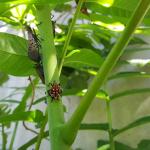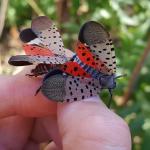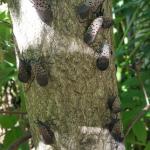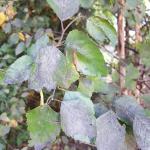Spotted Lanternfly Management
Scientific Name: Lycorma delicatula
Common Name: Spotted Lanternfly (SLF)
Report SLF if found in Massachusetts, here: https://massnrc.org/pests/slfreport.aspx .
Host Plant(s) Common Name (Scientific Name)
American basswood (Tilia americana) (Nymph, Adult - US)
American beech (Fagus grandifolia) (Egg - US; Nymph - PA)
American hazelnut (Corylus americana) (Adult - NJ)
American hophornbeam (Ostrya virginiana) (Egg - US)
American hornbeam (Carpinus caroliniana) (Egg - US)
American sycamore (Platanus occidentalis) (Egg - PA; Adult - US)
Amur corktree (Phellodendron amurense) (Egg - South Korea; Nymph, Adult - US)
Amur maackia (Maackia amurensis) (Nymph - PA)
Apple (Malus spp.) (Adult - US)
Ash (Fraxinus spp.) (Egg - South Korea; Adult - US)
Asiatic dogwood (Cornus officinalis) (Nymph, Adult - location of report unknown)
Autumn olive (Elaeagnus umbellata) (Nymph, Adult - location of report unknown)
Bigtooth aspen (Populus grandidentata) (Nymph, Adult - US)
Blackberry, raspberry (Rubus spp.) (Nymph - PA)
Black cherry (Prunus serotina) (Egg, Adult - US; Nymph - PA)
Blackgum (Nyssa sylvatica) (Nymph, Adult - PA)
Black locust (Robinia pseudoacacia) (Nymph - PA)
Black walnut (Juglans nigra) (Nymph, Adult - PA) *Preferred host of nymphs and adults throughout most of the season.
Boxelder (Acer negundo) (Egg, Nymph - PA)
Butternut (Juglans cinerea) (Nymph, Adult - PA) *Preferred host of nymphs and adults throughout most of the season.
Canadian serviceberry (Amelanchier canadensis) (Record: US)
Chinese boxwood (Buxus sinica) (Record: China)
Chinese juniper (Juniperus chinesis) (Nymph, Adult - China)
Corkscrew willow (Salix matsudana) (Nymph, Adult - US)
European white birch (Betula pendula) (Nymph - US)
Flowering dogwood (Cornus florida) (Egg - US)
Forsythia (Forsythia spp.) (Nymph - PA)
Glossy privet (Ligustrum lucidum) (Record: China)
Greater burdock (Arctium lappa) (Nymph - PA)
Hemp (Cannabis sativa) (Record: China)
Hibiscus (Hibiscus spp.) (Nymph - PA)
Honeysuckle (Lonicera spp.) (Nymph - PA)
Hops (Humulus japonicus, H. lupulus) (Nymph, Adult - PA)
Japanese boxwood (Buxus microphylla) (Record: China)
Japanese maple (Acer palmatum) (Egg - South Korea; Nymph, Adult - US)
Japanese snowbell (Styrax japonicus) (Egg - South Korea; Nymph, Adult - US)
Kousa dogwood (Cornus kousa) (Nymph, Adult - location of report unknown)
Lowbush blueberry (Vaccinium angustifolium) (Nymph - PA)
Northern red oak (Quercus rubra) (Egg, Nymph - PA)
Norway maple (Acer platanoides) (Egg, Nymph - PA; Adult - US)
Asiatic bittersweet (Celastrus orbiculatus) (Nymph - PA, NJ; Adult - PA)
Paper birch (Betula papyrifera) (Nymph, Adult - US)
Peach, nectarine (Prunus persica) (Adult - US)
Persian silk tree (Albizia julibrissin) (Record: China)
Pignut hickory (Carya glabra) (Nymph, Adult - US)
Poinsettia (Euphorbia pulcherrima) (Adult - PA)
Poison ivy (Toxicodendron radicans) (Nymph - PA)
Red maple (Acer rubrum) (Egg - US; Nymph, Adult - PA) *Preferred host of early season nymphs and adults throughout the season.
River birch (Betula nigra) (Egg - PA) *Preferred host of older nymphs and adults throughout the season.
Rose (Rosa spp.) (Nymph - PA) *Preferred host of early season nymphs.
Sassafras (Sassafras albidum) (Egg - PA)
Shagbark hickory (Carya ovata) (Egg, Nymph, Adult - US)
Silver maple (Acer saccharinum) (Egg, Nymph, Adult - PA) *Preferred host of early season nymphs and adults throughout the season.
Slippery elm (Ulmus rubra) (Nymph, Adult - US)
Staghorn sumac (Rhus typhina) (Nymph, Adult - PA) *Preferred host of older nymphs and adults throughout the season.
Sugar maple (Acer saccharum) (Nymph, Adult - PA)
Sweet birch (Betula lenta) (Egg, Nymph - PA)
Sweet cherry (Prunus avium) (Egg - US)
Sycamore maple (Acer pseudoplatanus) (Nymph - US)
Tea (Camellia sinensis) (Record: China)
Tree-of-heaven (Ailanthus altissima) (Egg, Nymph, Adult - PA, US) *Preferred host of nymphs and adults throughout the season.
Trident maple (Acer buergerianum) (Record: China)
Tuliptree (Liriodendron tulipifera) (Egg, Nymph, Adult - PA)
Virginia creeper (Parthenocissus quinquefolia) (Nymph - PA; Adult - South Korea)
Walnut (Juglans spp.) (Multiple records.)
Weeping willow (Salix babylonica) (Nymph, Adult - PA) *Preferred host of older nymphs and adults throughout the season.
White ash (Fraxinus americana) (Egg, Nymph, Adult - US)
White poplar (Populus alba) (Egg - South Korea)
Wild grape (Vitis spp.) (Nymph, Adult - PA) *Preferred host of nymphs and adults throughout the season.
Willow (Salix spp.) (Egg, Nymph, Adult - US) *Preferred host of older nymphs and adults throughout the season.
Wine grape (Vitis vinifera) (Nymph, Adult - PA) *Preferred host of nymphs and adults throughout the season.
Yellow birch (Betula alleghaniensis) (Egg - PA)
Insect Description
There is one generation of spotted lanternflies per year*. The eggs overwinter in a mass which the previous season's females lay on trees, shrubs, outdoor furniture, and other surfaces. The eggs themselves are brown and seed-like, and laid in vertical columns, with 30-50 eggs per mass. Female lanternflies secrete a white coating over the egg mass that looks like gray mud or lichen when it dries. This coating cracks and wears away over time, and sometimes females do not completely coat the egg mass. While adult spotted lanternflies may be present in late July (in PA), females begin laying egg masses in September and continue until frost.
Overwintered eggs begin to hatch approximately in late April to June (in PA) and the nymphs (immatures) undergo 4 different instar stages. The 1st through the 3rd instar nymphs are all black with white spots, and progressively grow larger in size. (1st instar nymphs may be 1/8 of an inch long and 4th instar nymphs are approximately 1/2 inch long.) The 4th instar nymphs develop red patches over the black with white spots and are present from July through late August. Fourth instar nymphs develop into adults beginning in August but may linger with adults through mid-September. Both the nymphs and the adults use piercing-sucking mouthparts to remove host plant fluids. Nymphs may prefer to feed on the vegetative parts of their host plants, while adults may also be found feeding on woody plant parts, including through the bark. Adults can be present from late July until frost at the start of winter.
Adult spotted lanternflies have gray forewings with black spots, black legs, and a black head with short orange antennae that may be mistaken for eyes. Adult hindwings are black-tipped, followed by a white band and a red area with black spots closest to the abdomen of the insect. The hindwings are brightly colored and very noticeable. When the adult is at rest the hindwings are obscured, making lanternflies very good at blending in with their environment. The abdomen of the adult is black and yellow. Adult lanternflies are approximately 1 inch long and 1/2 inch wide when at rest.
The MA Department of Agricultural Resources has made spotted lanternfly look-alike guides for each life stage of the insect, as well as a separate guide for egg masses. They can be viewed here:
SLF Look-alikes in MA & SLF Egg Mass Look-alikes are available here: https://massnrc.org/pests/pestFAQsheets/spottedlanternfly.html .
*Note that the spotted lanternfly is relatively new to Massachusetts. Therefore, details about life cycle timing and its impact on host plants in our location are still being studied and understood.
Damage to Trees and Crops
Spotted lanternflies feed on many plant species, but are typically first seen on grapes and tree-of-heaven. The host plant list above is derived from Barringer and Ciafre (2020). Both the adult and immature life stages of the spotted lanternfly use piercing-sucking mouthparts to feed on their host plants. They remove massive quantities of host plant fluid, and excrete it as a liquid excrement known as honeydew. Honeydew can be seen and feels like light rain or mist coming from the canopy of infested trees. It will coat the surface of any objects (including other plants) below. By August in Massachusetts, many hymenopterous insects (ants, bees, and wasps) are very much attracted to this honeydew, and the activity of the swarming wasps and bees that are feeding on the honeydew is often easier to spot than the lanternflies themselves. Black sooty mold can also be found growing on surfaces (and leaves) coated in honeydew. Leaf loss of small diameter tree-of-heaven has been seen in MA and other states due to the feeding activity of this insect, and branch dieback and flagging has been seen on black walnut in PA. Vineyards in PA have been documented to have suffered losses of grapes due to spotted lanternfly feeding. The impact of this insect on all of the host plants listed above is not fully understood at this time. Observations from PA indicate that the nymphs have a broad host range and will feed on virtually any new or tender plant growth. Adults, on the other hand, seem to prefer the woody stems of certain tree species and vines, including tree-of-heaven. Spotted lanternfly is considered to be a plant stressor, which when combined with other biotic or abiotic plant stresses, may contribute to significant damage to their host plants. However, some hosts (grapes, tree-of-heaven, maple, black walnut) may be at more risk than others. Feeding damage can also result in yield loss or quality reduction of agricultural crops.
Monitoring
Egg masses can typically be seen stuck to flat surfaces, including host plants but also wood, furniture, stone, buildings, outdoor equipment, etc. from approximately September through June. (See monitoring checklists from the MA Department of Agricultural Resources, here: https://massnrc.org/pests/pestFAQsheets/spottedlanternfly.html .) Depending upon weathering, old egg masses may persist longer. Managers may find using growing degree day/egg hatch prediction maps for spotted lanternfly emergence helpful. Examples of such maps can be found here: https://tools.cei.psu.edu/slf/ and here: https://safaris.cipm.info/safarispestmodel/StartupServlet?pestcast .
First through third instar nymphs may be found from late April/May through July, but a few individuals have been spotted into August in Massachusetts. Earlier instar nymphs may move up and down their host plants as they feed. Fourth instar nymphs (red) can be seen in July - September. Adults are present in late July and will last until frost. In August, it might be helpful to scout for the presence of swarming wasps, bees, and ants that are attracted to the honeydew excreted by spotted lanternflies.
Monitoring for the presence of spotted lanternfly is extremely important. Spotted lanternflies have strong host preferences for specific trees, but these preferences vary depending upon the hosts that are available in the surrounding landscape. As a result of monitoring, managers will see that not every host plant on this list needs to be treated. If spotted lanternfly is found in a landscape and persists, treatment may be considered on the host plants that are being favored in a specific landscape. (For example, in a PA study, red maple held 94% of the SLF population in a study area that also contained crabapple, sycamore, and others.) Host plant preferences for the spotted lanternfly also fluctuate through the season and with factors that are not yet completely understood (ex. weather conditions, plant senescence, etc.).
Monitoring can be conducted visually, using circle traps with protective coverings to avoid accidental bycatch of non-target organisms, and various other traps currently being researched. Lures are also still being developed for this insect. A relatively new monitoring technique for spotted lanternfly egg masses has also been developed. See the link to "Lampshade Trap Construction for Spotted Lanternfly Egg Masses", here: https://www.stopslf.org/research-updates/meeting-reports-and-presentations/spotted-lanternfly-summit-2023/ .
|
Management Options |
Jan |
Feb |
Mar |
Apr |
May |
Jun |
Jul |
Aug |
Sep |
Oct |
Nov |
Dec |
|---|---|---|---|---|---|---|---|---|---|---|---|---|
|
Don’t move any life stage of SLF. |
||||||||||||
|
Scrape & destroy egg masses. |
* |
|||||||||||
|
Spray egg masses with dormant oil. |
||||||||||||
|
Use traps to capture individuals. |
||||||||||||
|
Apply contact insecticides (after hatch and avoid plant bloom.) |
||||||||||||
|
Apply systemic applications. |
** |
*** |
|
Table derived from PennState Extension spotted lanternfly management guide.
Yellow shaded areas represent times of year when the management options on the left may be utilized to manage spotted lanternfly in Massachusetts.
*First egg masses may be laid mid-to-late September in MA.
**Blue shaded areas represent times of year when systemic applications of imidacloprid can be applied (May - July), after plant bloom.
***Red shaded areas represent times of year when systemic applications of dinotefuran can be applied (July - September), after plant bloom.
Cultural Management
Egg mass surveys can be performed from late September through May when the eggs hatch. Egg masses that can be safely reached should be scraped from host plants or other surfaces and destroyed, either by smashing the eggs inside or scraping the mass and depositing it into a container with rubbing alcohol. Remember - egg mass scraping will not get rid of the entire population of spotted lanternfly in an area, nor will it prevent adults from migrating into new locations later in the season. Additionally, it is estimated that less than 2% of the egg masses in an area are laid by SLF females at a reachable height (6 ft. or lower). It is thought that approximately 98% of the egg masses will be found higher up and out of reach in the canopy. Circle traps or sticky bands can be used to trap the nymphs and adults from May through October. Care should be taken with sticky bands by placing mesh over the bands to prevent non-target organism impacts. Effective lures for spotted lanternfly are still being studied, although some use wintergreen oil (methyl salicylate). Currently, it may be more effective to put a trap without a lure on tree-of-heaven, SLF's preferred host. Some land managers are experimenting with the use of backpack vacuums to remove adult spotted lanternflies from areas where insecticides are not an option or are undesirable. If vacuuming up adult spotted lanternflies, keep in mind that not all individuals may be killed by this process. The catch container in the vacuum should be cleaned after each use, and any lanternflies destroyed, to avoid accidental transport of individuals. Anecdotally, right-angle vacuum attachments further facilitate adult lanternfly captures. Batteries in these backpack vacuums might last approximately one hour, but times may vary.
Natural Enemies & Biological Control
While some organisms have been found predating upon the spotted lanternfly, none are currently believed to be able to significantly reduce populations of this insect below damaging or nuisance levels. Generalist predators such as mantids, spiders, and birds have been observed feeding on spotted lanternflies. A parasitoid wasp (Ooencyrtus kuvanae) which was introduced in the early 1900s for spongy moth (Lymantria dispar) biological control has been observed parasitizing some of the eggs in spotted lanternfly egg masses, but not at levels high enough to reduce SLF populations. Some fungal pathogens have also been observed acting on spotted lanternfly populations to a limited extent. Beauvaria bassiana and Batkoa major were observed causing an epizootic on a spotted lanternfly population on October 9, 2018 in Reading, PA on approximately 161 trees in this location (72% were tree of heaven) (Clifton et al., 2019).
Currently there are no natural enemies or biological control agents that have been identified as reducing or able to reduce populations of the spotted lanternfly in the United States. Researchers are currently surveying the native range of this insect in search of a suitable biocontrol organism that is specific to the spotted lanternfly.
Chemical Management
Please note that spotted lanternfly may not be explicitly included on many/any of the labels for products containing the active ingredients listed below. In Massachusetts, you may be able to apply certain products to manage spotted lanternfly if the site onto which they are applied is included on the label (ex. ornamental or shade trees and shrubs) and the label does not specifically refer to application rates for specific pests. It is recommended that professionals select active ingredients that have been used in ongoing efficacy trials that scientists are conducting to determine best management practices for this insect. This is because unless an insect species is included on a pesticide product label, there may not be available data to support the efficacy of that product at managing that insect. If you have any questions about Massachusetts laws governing pesticide use, please contact MDAR's Pesticide Program: https://www.mass.gov/orgs/pesticide-program .
Chemical management may include increased costs and additional risks to the environment and human health. Chemical management should only be used if high-risk, high-value plants are present (ex. young plants or vineyards in close proximity to favored hosts such as tree-of-heaven, maples, willow, or birch) where an established population of spotted lanternfly exists. Only use registered insecticides to kill spotted lanternfly. Read and follow all label instructions. Choose the least-toxic insecticide that is effective. Protect yourself and the environment from exposure.
-
Beta-cyfluthrin (pyrethroid)
-
Contact insecticide; products used on nymphs and adults; excellent activity against SLF reported with up to 2 weeks of residual activity.
-
-
Beauvaria bassiana (biopesticide; fungus)
-
Reduced risk; note that there is currently insufficient data on the efficacy of products containing this active ingredient on managing spotted lanternfly. While initial trials may be intriguing, further scientific study to confirm whether or not acceptable levels of population reduction can be achieved with products containing Beauvaria bassiana that are labeled for use on trees and shrubs in ornamental landscapes is needed. A 2019 study in southeastern PA used commercialized mycoinsecticides (containing B. bassiana strain GHA) on SLF populations in a public park. A single application reduced 4th instar nymphs by 48% after 14 days and applications to adults in the same park reduced adult populations by 43% after 14 days. The study also found that B. bassiana spores remain viable on foliage 5-7 days after spraying. An oil-based formulation of B. bassiana strain GHA (product: Aprehend©*) killed 99% of adult SLF after 9 days of exposure to residues on sprayed grapes. Researchers noted that the oil-based application of B. bassiana strain GHA also caused immediate mortality after direct contact with the application due to the oil-based formula (Clifton et. al 2020). These trials should be considered preliminary and may not yet support the use of products containing B. bassiana for the management of SLF without further study. However, scientists are currently working on this issue and more information should be available soon. *Aprehend© is currently labeled for indoor use only, and when researchers applied the product outdoors, they had to do so specifically with permission to conduct the research and it required off label use approval and documentation.
-
-
Bifenthrin (pyrethroid)
-
Contact insecticide; products used on nymphs and adults; excellent activity against SLF reported with up to 2 weeks of residual activity.
-
-
Carbaryl (carbamate)
-
Contact insecticide; products used on nymphs and adults; excellent activity against SLF reported; poor residual activity.
-
-
Dinotefuran (neonicotinoid)
-
Systemic insecticide; products used on adults; excellent activity against SLF reported; excellent residual activity; soil drench, trunk spray, or trunk injection.
-
-
Horticultural and Dormant Oils
-
Reduced risk; contact insecticide; products used on nymphs and adults; good activity against SLF reported; poor residual activity.
-
-
Imidacloprid (neonicotinoid)
-
Systemic insecticide; products used on adults; variable activity against SLF reported (soil drench, trunk injection); excellent residual activity as a trunk injection.
-
-
Insecticidal Soap (products often include potassium salts of fatty acids)
-
Reduced risk; contact insecticide that kills via suffocation/dehydration; products used against nymphs and adults; good activity against SLF reported; poor residual activity.
-
-
Malathion (organophosphate)
-
Contact insecticide; products used on nymphs and adults; excellent activity against SLF reported; poor residual activity.
-
-
Neem oil (botanical insecticide)
-
Reduced risk; contact insecticide; products used on nymphs and adults; good activity against SLF reported; poor residual activity.
-
-
Pyrethrins (botanical insecticide)
-
Reduced risk; contact insecticide; products used on nymphs and adults; excellent activity against SLF reported; poor residual activity.
-
-
Zeta-cypermethrin (pyrethroid)
-
Contact insecticide; products used on nymphs and adults; excellent activity against SLF reported; poor residual activity.
-
Contact insecticides require direct contact with spotted lanternfly to be effective. Systemic insecticides move throughout the plant and lanternflies are exposed by feeding on plant parts. These active ingredients may pose risks to pollinators and non-target organisms. Follow all label instructions for safety and proper use. For more information, visit: https://ag.umass.edu/landscape/fact-sheets/tree-shrub-insecticide-active-ingredients-risks-to-pollinators-other-non .
Dormant oils can be used on spotted lanternfly egg masses in March and April, or when local temperatures allow (prior to egg hatch in May). Thorough coverage of the egg masses (prior to hatch) is required for these applications to be effective. Remember that some plants are sensitive to horticultural or dormant oil applications. Contact insecticides can be used following egg hatch to treat the nymphs and adults; avoid plant bloom to protect pollinators. Applications at times of the day and temperatures when pollinators are less likely to be active can also reduce the risk of impacting their populations. Systemic insecticides can be used to treat adults following host plant bloom. For more information about chemical active ingredients that have been tested against spotted lanternfly, visit: https://extension.psu.edu/spotted-lanternfly-management-guide .
Note: Beginning July 1, 2022, neonicotinoid insecticides are classified as state restricted use for use on tree and shrub insect pests in Massachusetts. For more information, visit the MA Department of Agricultural Resources Pesticide Program.
Further Resources for Massachusetts:
The MA Department of Agricultural Resources also provides a "Spotted Lanternfly: Management Guide for Homeowners in Infested Areas", here: https://massnrc.org/pests/pestFAQsheets/spottedlanternfly.html .
Authors:
Tawny Simisky, Landscape, Nursery and Urban Forestry Program
Dr. Jaime Piñero, Stockbridge School of Agriculture and Extension Fruit Program
Dr. Elizabeth Barnes, MA Department of Agricultural Resources
Dr. Jennifer Forman Orth, MA Department of Agricultural Resources
Taryn LaScola-Miner, MA Department of Agricultural Resources






